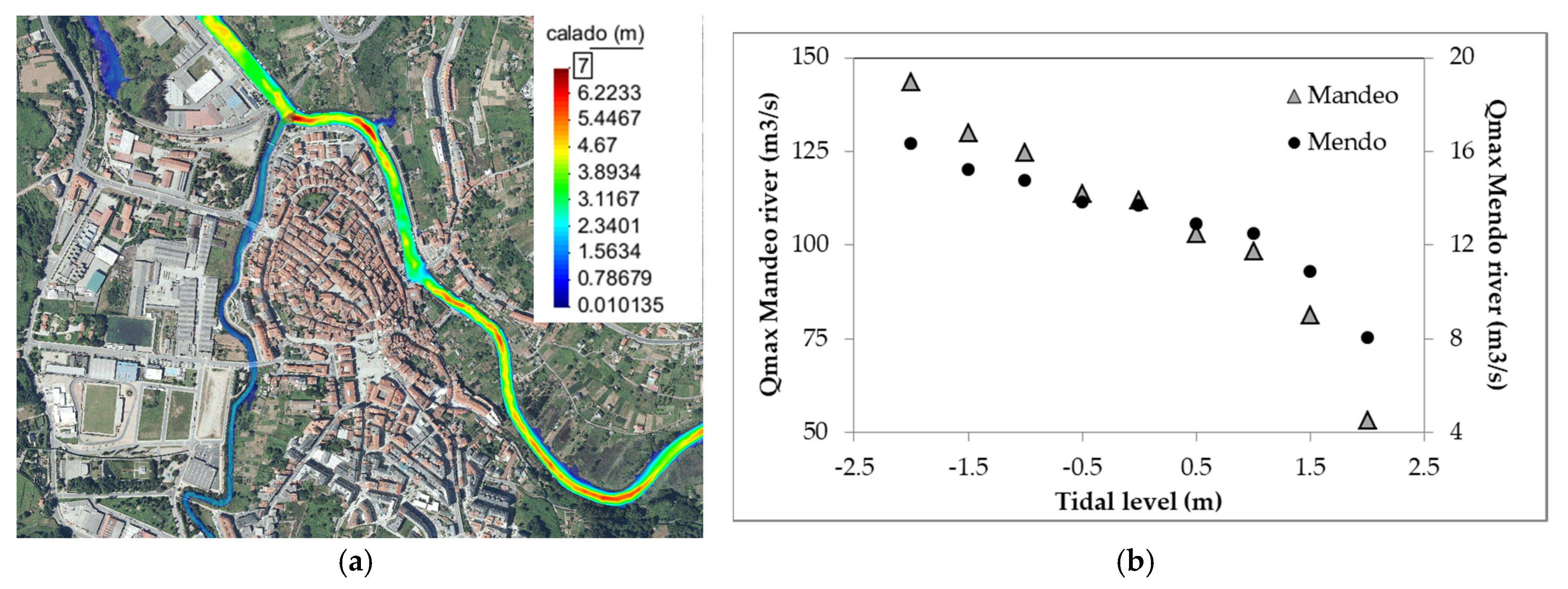1. Introduction
Floods are the most frequent natural disaster. Over the last two decades they have affected more than 2.500 million people and caused economic damages worth 625 billion dollars. Urban environments are becoming more sensitive to flood events due to the increase of the catchments imperviousness and the anthropic pressure on waterways.
This fact becomes significant for the urban waterways of the Galicia region. This region, located at the Northwest of Spain, has a very dense river network characterized by short rivers, many of them with important localities situated at the river discharge. Urban floods in Galicia are conditioned by both the amount of rainfall conveyed by the river and the tidal level at the discharge. During high tides, the sea level at the river outlet causes a backwater effect which reduces the waterway capacity. In this article, a study to quantify the effect of tidal level on the river discharges of two urban river reaches is presented.
2. Study Case
The studied rivers correspond to the Mendo and the Mandeo rivers, which comprise draining areas of 353 and 84 km2 respectively. The lengths of the rivers are 50 km (Mandeo) and 30 km (Mendo) and both of them run along predominantly forest and agricultural lands. Due to its location at the Atlantic coast, the studied catchments are located on the path of low pressure fronts, resulting in frequent adverse storm events characterized by a large spatial and temporal variability of rainfall. The locality of Betanzos (around 30,000 inhabitants) is located at the junction of the Mendo and Mandeo rivers and suffers frequent floods.
3. Methodology
The effect of the tidal level on the maximum discharge capacity of the Mendo and the Mandeo rivers was analyzed using the Iber model [
1]. This bidimensional flow model was used to simulate the hydrodynamic of the rivers on their pass through the locality of Betanzos. The model extended from approximately 1 km upstream the locality to the discharge of the Mandeo river at the Betanzos estuary. The domain was discretized in an unstructured mesh with elements size ranging between 60 m (at the estuary) to 1.5 m (at the river reaches along the locality of Betanzos). The elevation of each element was interpolated from the Digital Elevation Model provided by the Instituto Geográfico Nacional (IGN) with a spatial resolution of 5 m.
An inflow was imposed at each boundary condition of the Mendo and Mandeo rivers, increasing from 0 to 400 m
3/s during 36 h for the Mandeo river, and from 0 to 34 m
3/s during the same 36 h for the Mendo river. At the outlet boundary, a constant water level was imposed. Multiple simulations were performed with different levels in order to reproduce the tidal levels reported by the National Port Authorities of Spain for the Betanzos estuary. The maximum discharge was considered as the one that caused the river to overflow the natural waterway, as illustrated in
Figure 1.
4. Results
Results show a significant decrease of the maximum discharge with the increase of tidal level (
Figure 1). During the peak of spring tides, maximum discharge is nearly one third of the one corresponding to low tide in both rivers. Therefore, flood studies should be performed taking into account the impact of tidal level on the flood extent and the maximum discharge conveyed by the rivers.
Author Contributions
I.F. was responsible of the presented study, analysis and publication of the results.
Acknowledgments
This work received financial support from the Xunta de Galicia (Centro singular de investigación de Galicia accreditation 2016–2019) and the European Union (European Regional Development Fund-ERDF).
Conflicts of Interest
The author declares no conflict of interest. The founding sponsors had no role in the design of the study; in the collection, analyses, or interpretation of data; in the writing of the manuscript, and in the decision to publish the results.
Reference
- Bladé, E.; Cea, L.; Corestein, G.; Escolano, E.; Puertas, J.; Vázquez-Cendón, E.; Dolz, J.; Coll, A. Iber: herramienta de simulación numérica del flujo en ríos. Rev. Int. Metod. Numer. 2014, 30, 1–10. [Google Scholar] [CrossRef]
| Publisher’s Note: MDPI stays neutral with regard to jurisdictional claims in published maps and institutional affiliations. |
© 2018 by the author. Licensee MDPI, Basel, Switzerland. This article is an open access article distributed under the terms and conditions of the Creative Commons Attribution (CC BY) license (https://creativecommons.org/licenses/by/4.0/).





